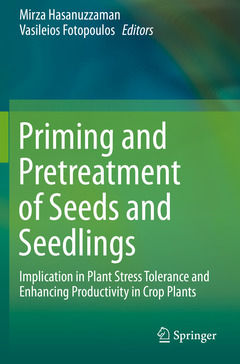Priming and Pretreatment of Seeds and Seedlings, 1st ed. 2019 Implication in Plant Stress Tolerance and Enhancing Productivity in Crop Plants
Langue : Anglais
Coordonnateurs : Hasanuzzaman Mirza, Fotopoulos Vasileios

This book introduces readers to both seed treatment and seedling pretreatments, taking into account various factors such as plant age, growing conditions and climate. Reflecting recent advances in seed priming and pretreatment techniques, it demonstrates how these approaches can be used to improve stress tolerance and enhance crop productivity.
Covering the basic phenomena involved, mechanisms and recent innovations, the book offers a comprehensive guide for students, researchers and scientists alike, particularly Plant Physiologists, Agronomists, Environmental Scientists, Biotechnologists, and Botanists, who will find essential information on physiology and stress tolerance. The book also provides a valuable source of information for professionals at seed companies, seed technologists, food scientists, policymakers, and agricultural development officers around the world.
Chapter 1: Methods of Seed Priming.- Chapter 2: Advances in the Concept and Methods of Seed Priming.- Chapter 3: Physiological, Biochemical and Molecular Aspects of Seed Priming.- Chapter 4: The Physiological, Biochemical and Molecular Basis of Seed Priming.- Chapter 5: Seedling Pretreatment: Methods and Protocols.- Chapter 6: Effect of the Seed Priming on Seed Dormancy and Vigor.- Chapter 7: Alteration in Plant Secondary Metabolism by Seed Priming.- Chapter 8: Seed Priming-Induced Early Vigor in Crops: An Alternate Strategy for Abiotic Stress Tolerance.- Chapter 9: Seed Priming Alleviates Stress Tolerance in Rice (Oryza sativa L.).- Chapter 10: Seed Priming and Salt Stress Tolerance in Plants.- Chapter 11: Seed Priming-Mediated Improvement of Plant Morphophysiology Under Salt Stress.- Chapter 12: The Mechanisms of Seed Priming Proposed for Enhancing Plant Tolerance Under Salt Stress.- Chapter 13: Seed Priming and PretreatmentInduced Enhanced Tolerance To Drought and Salt Stress: Recent Advances.- Chapter 14: Seed Priming to Enhance Chilling Tolerance in Field Crops: An Overview.- Chapter 15: Seed Priming and Metal/metalloid Stress Tolerance in Plants.- Chapter 16: Advances in Heavy Metal Induced Stress Alleviation With Respect to Exogenous Amendments in Crop Plants.- Chapter 17: Seed Priming for Disease Tolerance in Plants.- Chapter 18: Seed Pretreatment for Pathogen Control.- Chapter 19: Hydropriming for Plant Growth and Stress Tolerance.- Chapter 20: Chemical Priming for Multiple Stress Tolerance.- Chapter 21: Abiotic Stress Tolerance in Plants by Priming and Pretreatment with Hydrogen peroxide.- Chapter 22: Abiotic Stress Tolerance in Plants Through Pre-Sowing Seed Treatments with Mineral Elements and Growth Regulators.- Chapter 23: Abiotic Stress Tolerance in Plants by Priming and Pretreatments with Phytohormones.- Chapter 24: Abiotic Stress Tolerance in Plants by Priming and Pretreatments with Ascorbic Acid.- Chapter 25: An Assessment of Efficiency of Zinc Priming on as Induced Phytotoxicity in Rice During Germination and Early Seedling Growth.- Chapter 26: Application of Endophytes through Seed Priming.- Chapter 27: Microbial Inoculation of Seeds for Better Plant Growth and Productivity.- Chapter 28: Role of Seed Priming and Plant Growth Promoting Rhizobacteria in Modulating Crops’ Responses to Salinity Stress.- Chapter 29: Pretreatment of Seedlings with Exogenous Protectants for Abiotic Stress Tolerance.- Chapter 30: Improving Antioxidant Defense in Plants through Seed Priming and Seedling Pretreatment.
Dr. Mirza Hasanuzzaman is Professor of Agronomy at Sher-e-Bangla Agricultural University in Dhaka. He received his Ph.D. on ‘Plant Stress Physiology and Antioxidant Metabolism’ from Ehime University, Japan with a scholarship from the Japanese government (MEXT). Later, he completed his postdoctoral research at the Center of Molecular Biosciences, University of the Ryukyus, Japan, as a recipient of the Japan Society for the Promotion of Science (JSPS) postdoctoral fellowship. He was also the recipient of the Australian Government’s Endeavour Research Fellowship for postdoctoral research as an Adjunct Senior Researcher at the University of Tasmania, Australia. Dr. Hasanuzzaman’s current work is focused on the physiological and molecular mechanisms of environmental stress tolerance. Dr. Hasanuzzaman has published over 80 articles in peer-reviewed journals. He has edited six books and written 30 book chapters on important aspects of plant physiology, plant stress tolerance, and crop production. According to Scopus®, Dr. Hasanuzzaman’s publications have received about 3,500 citations with an h-index of 30. He is an editor and reviewer for more than 50 peer-reviewed international journals and was a recipient of the ‘Publons Peer Review Award 2017 and 2018’. He has been honored by different authorities for his outstanding performance in different fields like research and education, and he has received the World Academy of Science Young Scientist Award (2014).
Vasileios Fotopoulos is Associate Professor in Structural and Functional Plant Biology and head of the CUT Plant Stress Physiology Group established in 2008. His main scientific research focuses on the study of nitro-oxidative signaling cascades involved in the plant’s response to stress factors, while emphasis is being given in the development of chemical treatment technologies towards the amelioration of abiotic stress factors and promotion of plant growth. To date
Offers an up-to-date compilation of recent advances in the field of seed priming Features 30 chapters with 35 figures (29 in color) and 34 tables contributed by 109 authors from around the globe Represents an essential source of information for both students and researchers working in seed science, agronomy, plant physiology and botany
Date de parution : 10-2020
Ouvrage de 604 p.
15.5x23.5 cm
Date de parution : 10-2019
Ouvrage de 604 p.
15.5x23.5 cm
Thèmes de Priming and Pretreatment of Seeds and Seedlings :
Mots-clés :
Cross tolerance; Abiotic stress; Seed biology; Priming and seedlings; Seed treatment
© 2024 LAVOISIER S.A.S.


